With the merger between Alaska and Hawaiian Airlines in full swing, we’ve both published details of the merger and talked on the podcast about wedding planning and winning post-merger. One thing I wondered aloud on the podcast was whether it would be worth considering a mileage run given my own circumstances. This post is an attempt to think through it and decide whether to take the leap or talk myself down off that ledge.
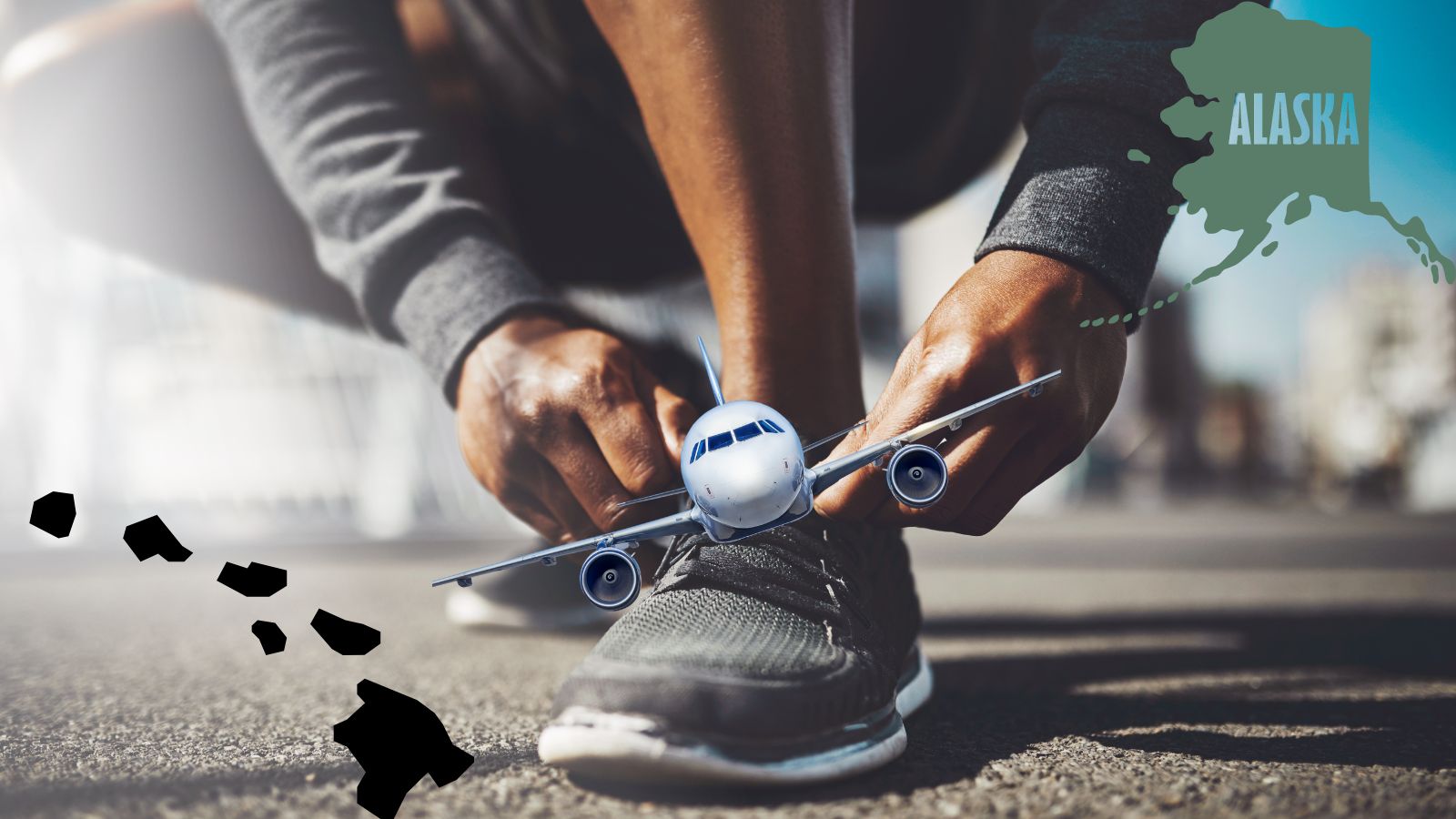
Hawaiian and Alaska merger is moving faster than we expected
The biggest key to all of this is the fact that the Alaska / Hawaiian merger is moving along must faster than we initially expected. Just yesterday, it became possible to transfer miles between Hawaiian miles and Alaska Mileage Plan at a 1:1 ratio. That will be great news for those who took advantage of the August transfer bonus to Hawaiian miles (now expired) since it means that those miles have become even more useful for those who value Alaska’s oneworld partnerships and award charts.
Beyond the mileage movement, there’s the question of elite status: elite miles earned in both programs are expected to be combined at some point this year. In other words, if you have earned elite mileage credit in both Alaska and Hawaiian’s programs, your combined earnings will determine your elite status in either program.
As someone who has earned some miles with Hawaiian’s program this year, I have to wonder whether it might be worth a mileage run for me to chase low-level elite status with Alaska.
My current status: 13,199 elite qualifying miles with Hawaiian
![]()
At the end of my 28,000-mile summer trip, I returned to New York by flying Hawaiian Airlines from Tokyo’s Narita airport to Honolulu and on to New York. I booked that flight as a paid airfare through Amex Travel. I did that because I found a great fare (about $1,480 per passenger for flat-bed business class) and I was able to use American Express Membership Rewards points to pay for it and get good value for points.
That is of course because I have the Amex Business Platinum card, which offers a 35% rebate when you pay with points for a flight in Business or First Class with any carrier (up to 1,000,000 points back per year). I used 148,000 points per passenger to initially pay for the flight and later received a rebate of 51,800 points per passenger for a net cost of about 96,200 points per passenger one-way.
Because that was a paid fare, we each earned both redeemable and elite-qualifying miles with Hawaiian Airlines at a rate of 150% of mileage flown. In this case, that means that each member of my family earned 13,199 redeemable miles and 13,199 elite-qualifying miles with Hawaiian Miles.
I hadn’t given those miles much thought (apart from how they’d eventually be useful when they became Alaska miles) until the announcement noting that elite earnings would be combined across the two programs this year. While I wouldn’t have cared much about earning elite status with Hawaiian Airlines, elite status with Alaska Airlines is potentially much more valuable to me given the fact that Alaska is a oneworld airline (so I’d receive benefits even when flying on partners like American Airlines) and the increased earning potential Alaska offers when flying some of its oneworld partners, which only get better with elite status.
Now I suddenly find myself (and all four members of my family!) just 6,801 elite qualifying miles from earning the first tier of elite status with Alaska. Making matters more interesting, an Alaska companion certificate could reduce the cost of our path to glory.
Alaska elite status levels and requirements

Alaska Mileage Plan’s first level of elite status is MVP and it requires 20,000 elite-qualifying flown with Alaska or its oneworld partners. Again, earnings from both Hawaiian and Alaska will be combined to determine 2025 status, so earning 20,000 combined elite-qualifying miles should eventually result in MVP status (and Hawaiian Pualani Gold for what that’s worth).
MVP status isn’t wildly exciting. In 2024, it comes with a 50% bonus on elite-qualifying miles, but beginning on January 1, 2025 that will drop to just a 25% bonus.
There’s a chance of scoring an upgrade on an Alaska flight close to departure, but as with most airlines, the chance is probably pretty slim given that all other elites are ahead in the pecking order.
MVP status does give you priority check-in, two free checked bags, and preferred seating. The accompanying oneworld Ruby status also gets you complimentary Preferred seating on oneworld partners, which would mean being able to take one of those “Preferred” rows on American Airlines flights and having access to select Main Cabin Extra at check-in.
One situation where I find Alaska status particularly appealing is for earning miles on paid premium cabin fares with select partners. For instance, paid British Airways premium cabin fares earn Alaska Airlines redeemable miles at a rate of 250% mileage flown. MVP members currently earn a total of 300% mileage flown with their elite bonus, though that will drop to 275% in 2025. A couple of years ago, I used the Amex Business Platinum pay with points rebate to pay around 110K net points for round trip business class from Europe to the US (to end one trip) and back to Europe (to begin another trip) and we each earned about 20,000 Alaska Mileage Plan miles without having any elite status. If we had elite status, we’d have earned even more!
As it turns out, I do have a trip booked to Europe next year. I currently have award flights booked in both directions, but I’d not be opposed to changing plans if I found the right price for a British Airways paid fare.
Still, that’s a fringe case that may or may not become relevant for me in 2025. Is it worth chasing status for relatively meager benefits? Probably not. I probably wouldn’t recommend someone else in my shoes chase status.
However, being that I write about stuff like this for a living, I had to run the numbers to see just how much it would cost me to earn status with a good old-fashioned mileage run in order to try to decide whether to take a gamble on finding out whether it ends up being worthwhile.
All four members of my family would be 6,801 miles short of status. Do we all need status? Probably not. If my wife and I could earn it cheaply though, I might be interested.
Leveraging an Alaska Companion Certificate

On the one hand, it seems kind of crazy to consider flying around on Alaska Airlines without cause beyond the chance to earn elite status that may or may not be valuable to me next year. After all, that comes with costs both in terms of time and money.
However, an Alaska Airlines Companion Certificate could reduce the cost of the mileage run.
My wife is an Alaska Airlines Business Visa cardholder. Her card has been open for a few years, so she gets the annual Companion Certificate as an ongoing benefit, whereas new cardholders since January 18, 2023 need to spend $6,000 in the cardmember year in order to earn a certificate.
The Alaska Companion Certificate is a benefit that we haven’t utilized at all over the past few years, but it can be quite a value since the companion pays just $99 plus taxes and both passengers earn full elite-qualifying and redeemable miles.
You can see where this is going. If I could find an itinerary that earns 6,801 elite qualifying miles, we would only pay full price for one passenger. The second passenger would also earn 6,800 elite-qualifying miles despite only paying $99 plus tax.
On the podcast, I theorized that a round trip from New York to Honolulu could probably be traveled over the course of a weekend for around six hundred bucks round trip. I had forgotten (even when I initially wrote this post) that Alaska now only awards 30% of mileage flown on Saver fares, so it turns out that my numbers were off by a bit. That said, $736.06 for a long weekend trip to Hawaii and Alaska MVP status for two seems like it might not be a bad deal.
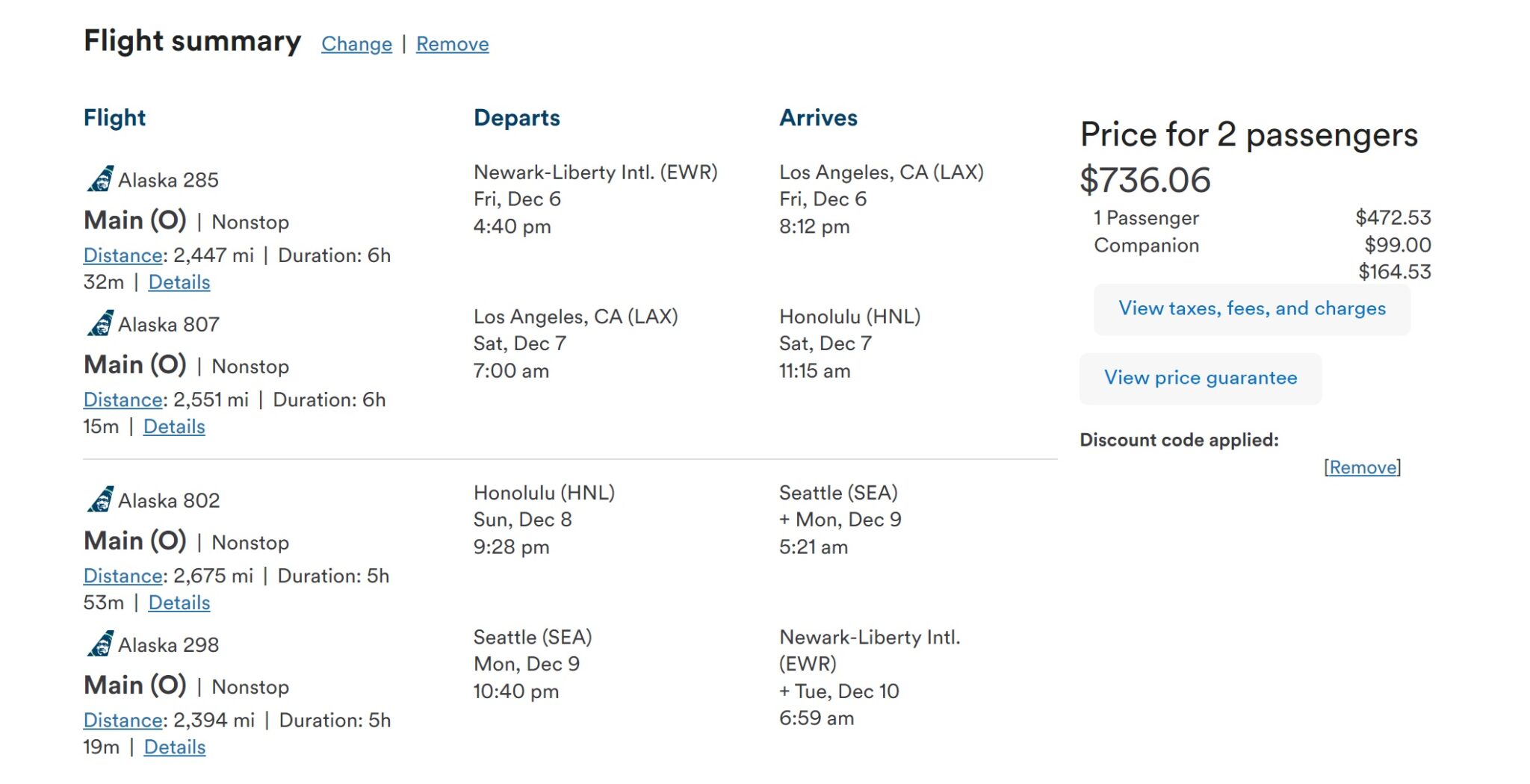
That works out to about $368 each and we could each earn more than 8,000 redeemable miles and also earn earn Alaska Mileage Plan status.
That’s not bad!
However, that itinerary includes an overnight/redeye from Seattle to Newark. Doing that in an economy class seat loses significant appeal.
As it turns out, Tim offered me the chance for Alaska MVP Guest upgrades if I decided to pursue this. I’ve only used a guest upgrade once or twice, but I know that the fare class requirement to use them is higher than the cheapest saver fares. Still, I found a slightly different itinerary to Hawaii that would have MVP Guest upgrades available at booking with a total fare of $965 for two passengers. For two passengers in first class to Hawaii and first class from Los Angeles to New York, that seems very reasonable.
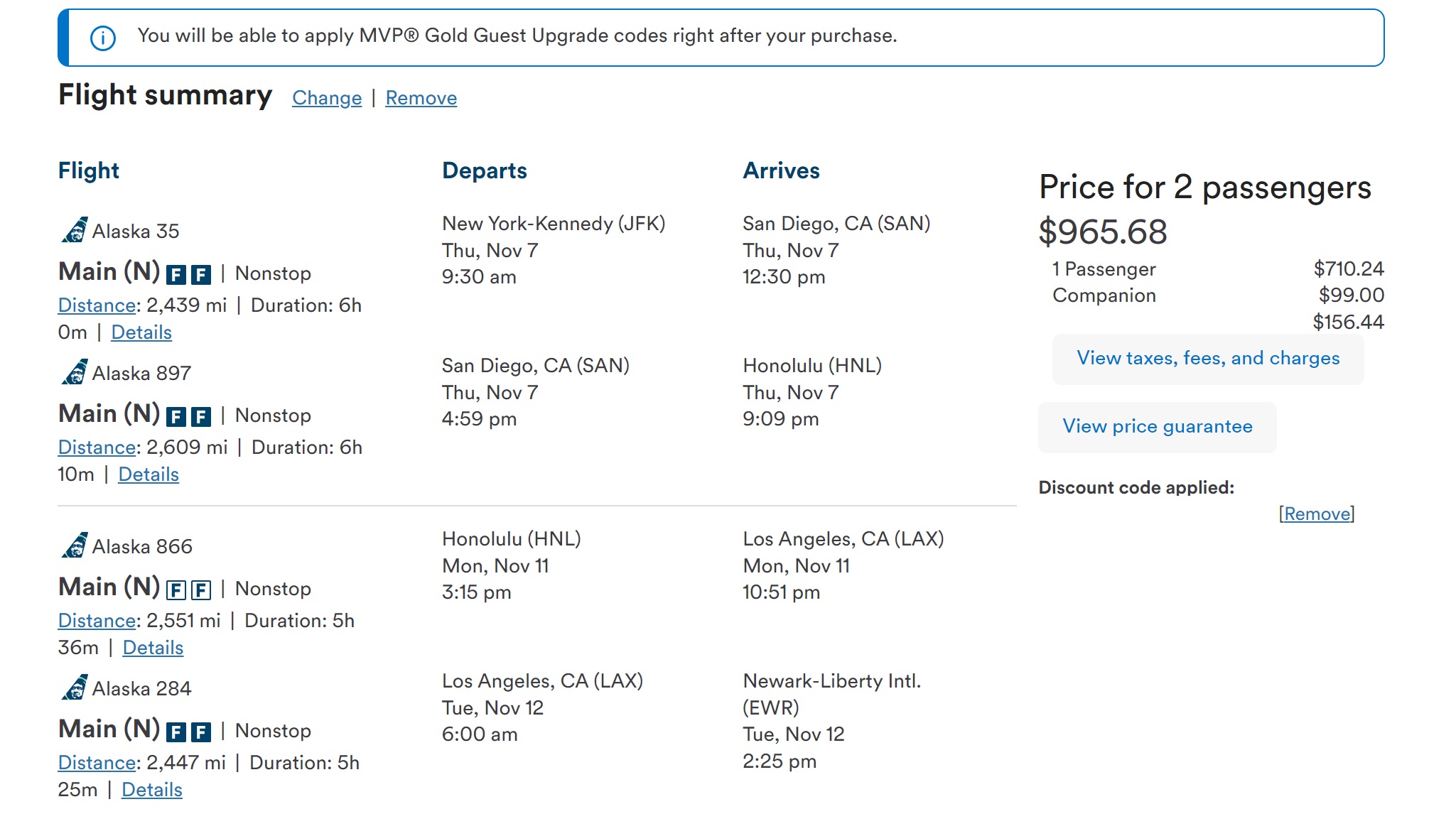
However, how many times has anyone ever said “that seems pretty reasonable” when talking about a weekend trip from New York to Hawaii? Probably not many.
While it wasn’t entirely impossible to figure out a Hawaii trip with all daytime flights (as seen above), in most cases the cheapest round trip itineraries included a redeye.
I next turned my attention to the west coast. Unfortunately, a simple round trip to the west coast wouldn’t earn enough elite-qualifying miles to reach status. Fortunately, an Alaska Companion Certificate doesn’t need to be used for a simple round trip. Also fortunate is the fact that Alaska has a robust west coast network.
I contemplated a weekend in November when the kids would have a little extra time off of school to make it a long weekend and found, as an example, this itinerary from New York to Seattle, to San Jose, to San Diego on a Thursday. Then, after spending Friday and Saturday in San Diego, it would be onward on Sunday from San Diego to Portland to spend almost 24 hours in Portland before returning to New York on Monday of a holiday weekend (Veteran’s Day). That example would cost us about $322 each to earn 6,906 miles — more than enough to earn to MVP status once those miles combine with the 13,199 elite qualifying miles we earned on Hawaiian.
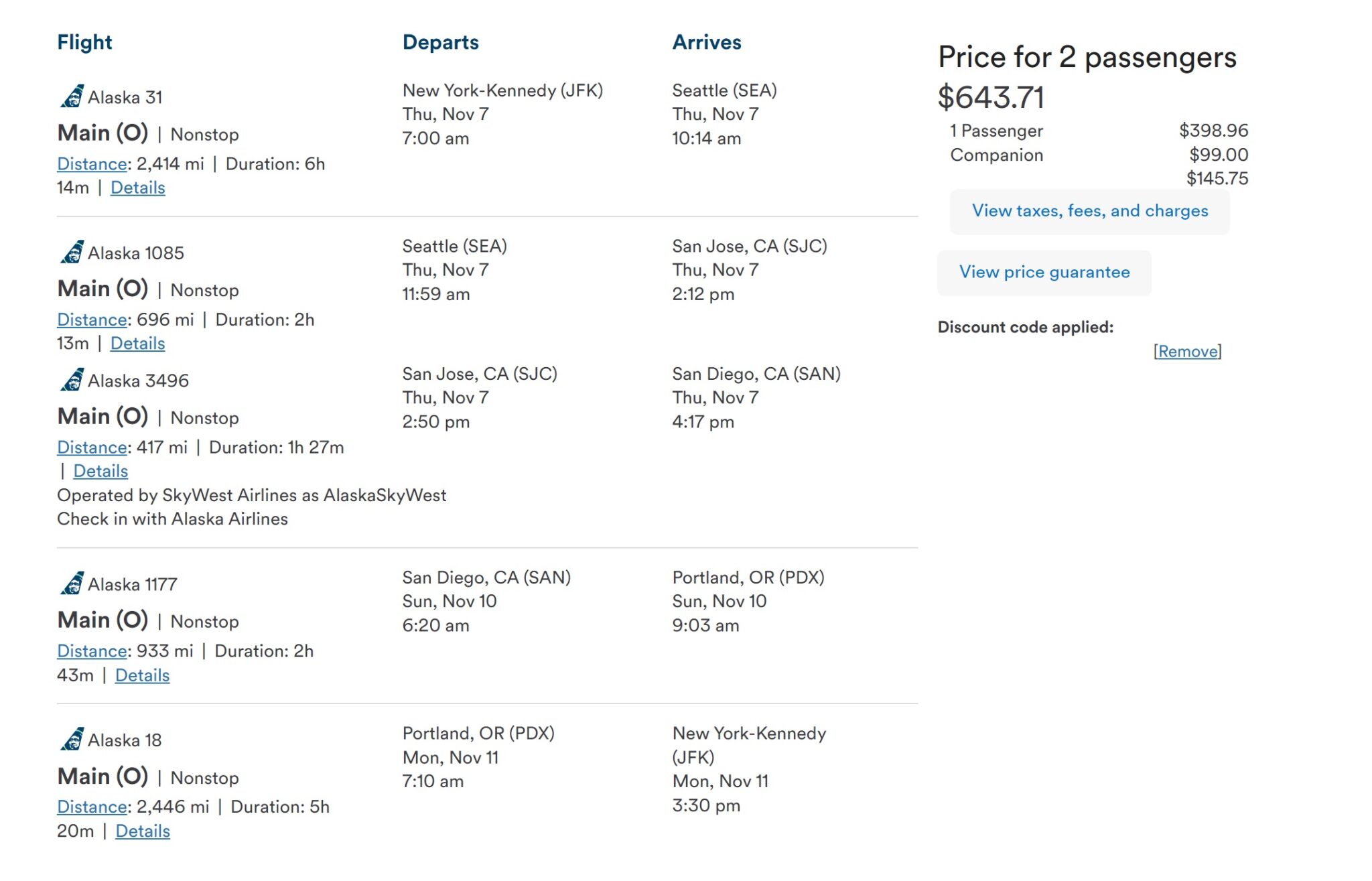
Obviously there would be additional costs like meals, local transport, hotels, etc. I wouldn’t necessarily include all of those costs since I’d pretty gladly trade being at home for being in San Diego almost any day of the week.
Could I do any better? Should we bring the kids?
To the second question, the initial problem is that we only have one Companion fare code since my wife has the sole Alaska Airlines credit card in our household right now. However, I soon realized that her current certificate is due to expire in just a couple of weeks. That means I expect she’ll get a new companion certificate very soon. If we wanted to do this with the kids, I think it’s possible that we could book two of us now with her Alaska Companion fare and then book the other two passengers in a couple of weeks when her new certificate posts.
Another option: credit card spend
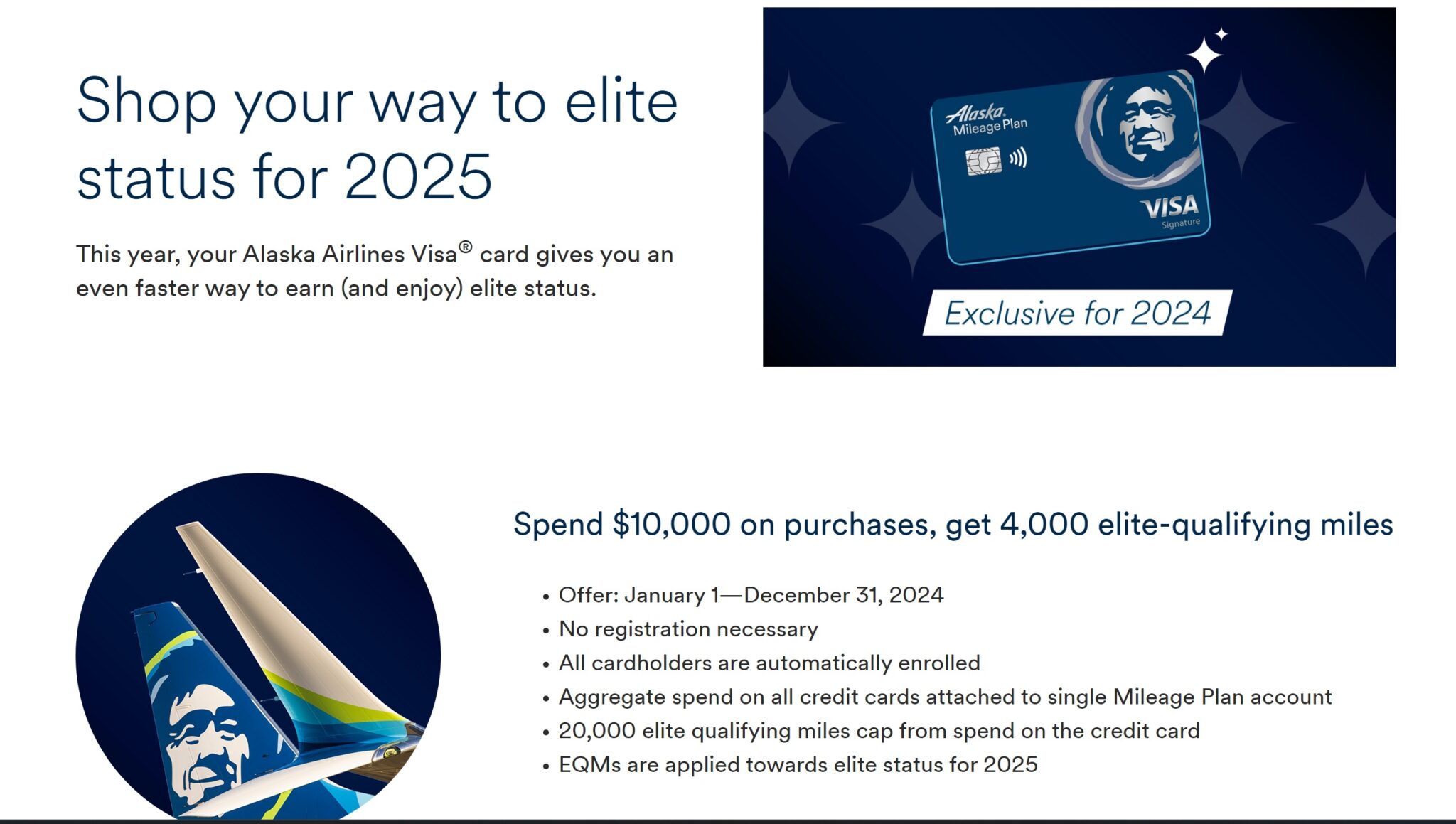
My wife has another option to bridge the gap and get to MVP status when things get combined: credit card spend.
This year, Alaska Airlines credit card holders (both business and consumer) can earn earn 4,000 elite qualifying miles for every $10,000 in purchases up to 20,000 elite qualifying miles.
Thanks to that, my wife could skip flying altogether: with $20,000 in purchases on her Alaska card, she would earn 8,000 elite qualifying miles. When combined with the 13,200 earned on the Hawaiian Airlines flights, that would be enough to get her MVP status.
Spending could certainly be preferable for some. After all, it could almost completely eliminate the time cost of a mileage run.
However, spending on an Alaska card is not without opportunity cost.
My wife could otherwise earn 2.625% cash back with her Bank of America Premium Rewards card with Platinum Honors. Since our Reasonable Redemption value of Alaska miles is 1.3c per mile, the opportunity cost of spending at 1x on an Alaska card could be looked at as being around 1.3%. In other words, at a base level, my wife would be giving up an additional $260 that she could be earning in cash back on that $20,000 in purchases if she were to use the Alaska card over her Premium Rewards card. At that comparison point, that would be a cheaper path to elite status than the cost of the mileage run (albeit without any time to enjoy in San Diego :-).
However, the true comparison looks a little different. That’s because my wife has targeted offers on a couple of her cards to upgrade to the Business Platinum card and earn 120,000 Membership Rewards points after $10,000 in purchases in the first 3 months.
In other words, $20,000 in purchases would earn her at least 260,000 Membership Rewards points (120K bonus points with each card plus the minimum 10,000 points earned from $10K spend on each card). In our specific circumstances, the opportunity cost of putting big spend on the Alaska card feels too high.
I’m not yet ready to cut this out entirely as a possibility, but I’m doubtful that spend will make sense.
Mileage running with American Airlines
We might have another possibility: mileage running with American Airlines. Since Alaska no longer requires a minimum number of miles flown on Alaska in order to earn status, it would be possible for us to fly American and credit those flights to Alaska in order to earn status.
However, it would be hard to imagine the scenario where we could earn at least 6,801 Alaska miles for less cost than the Alaska Companion Certificate scenarios. The one situation where maybe it could work out is with an American Airlines Companion Certificate. My wife and I both have the Aviator Silver card and have each spent $20K on it this year in order to earn an American Airlines Companion Certificate that’s good for two companions at $99 plus taxes each. If it were possible to use that and change the frequent flyer number on the reservations to our Alaska numbers, maybe it would be possible to build a similar scenario on American Airlines. However, we don’t yet have those companion certificates and won’t until fairly late this year. Furthermore, I don’t know whether it is possible to add an Alaska Airlines frequent flyer number to a reservation booked with an American Airlines companion certificate, but I would logically doubt that it could be done. Regardless, I probably won’t have enough time to wait for the certificates to post in order to book and find out, so I likely won’t be pursuing an American Airlines mileage run for Alaska status.
What will I do?
I had hoped that writing this post would help me decide whether to mileage run for Alaska Mileage Plan MVP status. Logically, it doesn’t make sense: there aren’t enough benefits at the MVP level, and we don’t have plans to fly Alaska or Hawaiian (or even oneworld carriers) enough next year for it to make sense for us to chase MVP benefits. On the flip side, I find it hard to resist fun opportunities like this to figure out what’s possible. At this point, I’m still not certain.
One thing might tip the balance for me: Miles Talk recently reported that The Venetian in Las Vegas is going to start an elite status match on October 1st that is scheduled to run through January 1st. We don’t yet have any details about what that will look like or what benefits one might receive. However, since I currently have Wynn Platinum status thanks to a match earlier this year for a free cruise, I’ll be very curious to see how the Venetian match plays out. If there are exciting benefits to be had, particularly if I can parlay my way to yet another free cruise, I might be very tempted to stack opportunities by flying a long companion fare weekend trip that includes a stop in Vegas long enough for a match. That still won’t be reasonable, but it might be fun. And at the end of the day, let’s not forget that this game is not only my job, but also my hobby. Some people play golf, others play chess, and others love a daily crossword puzzle. I love playing games for frequent flyer miles and elite status, so I might be tempted to play here for the love of the game even if it doesn’t turn out to be a big win.





Another little schene could be to buy the carbon offset to get at the 5000 EQM. Works out to 20 cents per elite qualifying mile.
Nick,
After reading this article, especially the paragraph with your thought about flying 12+ hours, with your wife, from NYC to HNL, for only a few quality hours in Hawaii. Then turning around and doing the 12+ hours again. I thought … SHE MUST REALLY LOVE YOU.
Nick, you already have an elite status that is so selective, only one person in the entire world can have it. If you go for it, don’t let the goal be the status, let it be creating a memory with her. Reverse engineer this from the the memory you wish to create.
I’m a bit surprised that you haven’t spent/flown your way to status on AA since they made it much easier.
I rarely fly revenue fares. The rare occasion where I do is when using the Business Platinum for something like a cheap British Airways business class fare combined with the Amex Platinum rebate (or like the Hawaiian one mentioned here). In that case, I’d rather be crediting to Alaska than AA. Anyway, that is to say that I wouldn’t be flying my way to AA status. I did play the Loyalty Points game and previously use the shopping portal to earn Platinum (and did the challenge for Platinum Pro for 6 months), but most of the really good shopping portal offers have dried up enough and I haven’t used my AA status for much (though I am flying the family domestically on AA soon enough and I guess we did get Preferred Seating for that!).
Anyway, moral of the story is that I do currently have AA Platinum, but I’ve only got 9K LPs for the current year and I’m definitely not going to spend enough on the card to earn Gold status. I’d consider doing stuff through the shopping portal, but I haven’t been as intrigued there for a while now.
Your point is general is a good one that it is relatively easy to get AA status. With Alaska, I’d have similar-to-AA benefits but I’d be more likely to want to credit something like a paid BA fare to Alaska than to American.
Hi Nick, maybe I’m missing something, but how is it possible that you only have 9K LPs if you spent $20K on the Aviator Silver this year?
The loyalty year for AA now runs March 1-Feb 28. I did most of the $20K spend before Feb 28 — in fact, if I remember correctly, I did most of it before 2/2 because I was on a status challenge. That counted for last year’s LPs since the spend was before 3/1.
Got it, thank you for explaining!
Just get aa status from loyalty point games. Works well on alaska.
Doing this mileage run would be the first time I’ve flown on Alaska in at least 5 or 6 years. I’m less interested in the benefits on Alaska. You might then reasonably wonder why I wouldn’t be pursuing AA status, but in this case I’m close enough to the first level with Alaska and far enough from the first level with AA as to make the mileage run interesting. Also, as noted in another response I just posted, I think there is some non-zero chance that I’ll stumble on an attractive British Airways business class fare and use points to book it and I’d rather be crediting that to Alaska than AA anyway.
There’s also something to be said about presenting an economy itinerary and then backfilling some of that content with a guest upgrade. Yes, it’s possible to have friends in today’s world, but many also don’t have direct access to those with status. Apples to apples. It’s similar to presenting “starting from xx miles to travel to yy” and realizing it’s typically East Coast (vs West Coast). Just a thought to consider
I enjoy most posts, but this one made my head hurt. lol
Don’t chase the monkey’s tail for a 25% mileage bonus that you don’t fly much …BE YOUR OWN ELITE
Miles do make do some crazy things …I’ve done crazier
Nick, I don’t come to Frequent Miler to read about reasonable things, I come here to read about extravagant, crazy, and fun things. I know whatever you decide to do, you won’t let me or other FM readers down 🙂
To newbies: Keep tier status in perspective. Always ask what it gives you and how much it costs to attain. (And, Nick offers an intellectually honest analysis.) Remember that, in the hobby, we aspire to earn enough points to cover all travel . . . in premium cabins. If we are successful in that, tier status provides which benefits that are not otherwise provided by a premium cabin ticket? Think about it.